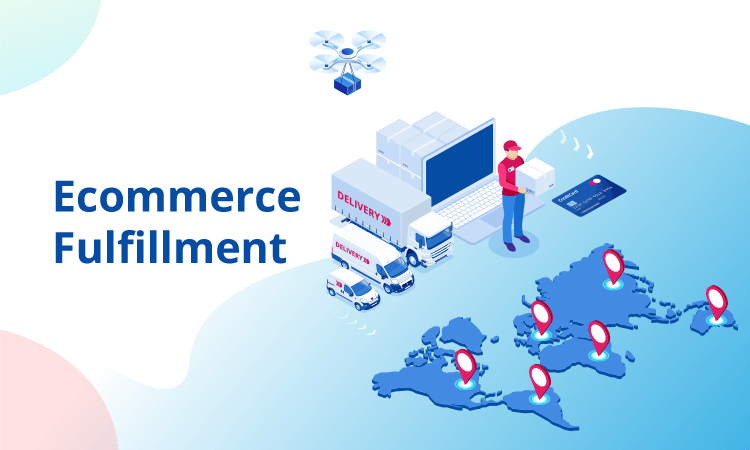In today’s competitive environment, merchants need to go the extra mile to organize the complex logistics that ensure goods reach their destination in a short timeframe.
Online buyers demand fast and reliable shipping. As of July and August 2021, Statista reported that more than 50% of global shoppers considered shipping speed the decisive purchase factor, while 38% stated that free/discounted delivery was an important criterion. In the US, these factors made a critical difference for more than 90% of buyers.
This article explores all the aspects of ecommerce fulfillment, including how to choose the best fulfillment provider for your growing business.
What Is Ecommerce Fulfillment?
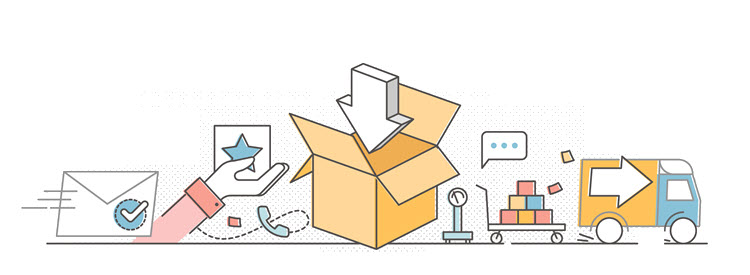
Ecommerce fulfillment is a series of procedures that begins at the checkout and finishes when the customer receives their order. It refers to all the operations that come after a customer has placed an order and includes some or all the following activities:
- Accepting orders
- Order and inventory management
- Warehousing
- Packaging and shipping goods
- Returns management
There are three major ecommerce fulfillment models:
1. Self-Fulfillment
In a self-fulfillment model, an ecommerce merchant runs all the fulfillment services in-house. This is a manageable option for merchants who have just started an ecommerce business.
Self-fulfillment is not easy to implement as it requires the smooth integration of separate elements, from storage and order management to packaging and shipping. As the workload and the number of orders increase, handling all these operations becomes a challenge. A rise in purchase volume easily leads to late shipment, incorrect orders, overlooked return requests, and other issues that can seriously damage a burgeoning business’s reputation.
2. Dropshipping

Dropshipping refers to a business that acts as a middleman between a manufacturer or wholesaler and customers. The merchant (dropshipper) neither holds nor stores the inventory. When a customer makes an order on the merchant’s website, the order and shipping information go straight to the supplier or manufacturer, who accepts the order and delivers the product.
The benefit of dropshipping is that merchants don’t have to handle warehousing and order processing. They set up an ecommerce store and make arrangements with manufacturers or suppliers regarding pricing models.
The main drawback of dropshipping is the limited control over how fulfillment is handled. If the manufacturer is late with the shipment or the goods are received damaged, the customer blames the merchant since their ecommerce store is where they placed the order.
3. Third-Party Fulfillment
In third-party fulfillment, merchants outsource their fulfillment services to a third party responsible for inventory storage and management, packaging, shipping, and return processing. Typically, one fulfillment company caters to multiple merchants, and they manage fulfillment centers where the goods are stored.
Merchants don’t have to outsource all the operations to the same third-party fulfillment operator. They can have their products stored and processed by one fulfillment provider and choose a different one to handle shipping. Also, some third-party fulfillment providers hire different carriers for different shipping needs.
Third-party fulfillment is the best option for growing and large businesses as it prevents order backlog and mitigates customer dissatisfaction. Partnering with a third-party fulfillment provider means being able to take more orders and upscale/downscale fulfillment services according to demand.
How Does Ecommerce Fulfillment Work?

To improve overall ecommerce fulfillment, it is crucial to understand how each stage of the process works. This helps merchants generate satisfied buyers who become recurring customers.
Obtaining Inventory
The first stage of the fulfillment procedure is transporting the products available on the merchant’s website to the distribution center. This can be the merchant’s business headquarters or warehouse. For merchants who work with third-party providers, it is usually the provider’s fulfillment center.
Inventory Management
Inventory management is the storing and tracking of all the products a merchant offers on their ecommerce website. Efficient customer fulfillment helps merchants track what products they have in stock and which ones they might soon run out of.
Businesses that opt for self-fulfillment can use any space to store their products, from an office balcony to a home basement. Merchants who hire the services of third-party fulfillment providers are usually offered the use of large warehouses and dedicated inventory centers.
Processing Orders
Processing orders (or order management) refers to accepting orders placed on the merchant’s ecommerce website. When a customer makes an order, the order management procedure begins. The product is selected, packed, and prepared for shipping.
Efficient order management ensures that no order is skipped or overlooked and that every order ends with accurate shipment. Order processing has to be closely aligned with inventory management to ensure that the relevant data is regularly updated and sold-out items are replaced.
At certain times of the year (e.g., the period between Thanksgiving and Christmas in the US), a merchant utilizing self-fulfillment might want to outsource some fulfillment services to a third party and downscale back to in-house fulfillment once the shopping rush is over.
Shipping

When the order is processed, it’s time to ship. The choice of shipping company depends on the merchant’s size, preferences, and business goals.
A small business handling a small number of orders can ship products through a variety of carriers, selected on the basis of shipment type. Larger merchants dealing with large order volumes usually partner with a third-party shipment company, which can be the same as the third-party fulfillment provider or a separate shipping company.
Customers buying online expect efficiency so sending and delivering products without delays plays a crucial part in reducing the churn rate and boosting customer loyalty.
Notifying Customers
Notifying the customer about their order status is a smart thing to do. Merchants wishing to use this option need to include a CRM tracking solution and send the tracking number to the customer. Once the product has been shipped, the customer receives a notification, and they can start following the shipment.
When customers can track their order, they call ecommerce customer service less frequently, which reduces the pressure on the merchant or the third-party provider.
Handling Returns
If a customer is not satisfied with the product, they can ask for a refund and return the product to the merchant.
Every business needs to have an established procedure for handling returns and paying refunds to their customers. Merchants utilizing self-fulfillment typically have their own return policies, while those using third-party fulfillment services develop their returns policy in line with their fulfillment partner.
What to Consider before Hiring a Fulfillment Company?
Here are the main things to consider before choosing a fulfillment company:
The Type of Products
The type of products a merchant sells determines the kind of support their ecommerce fulfillment needs. For instance, merchants handling large and heavy items have more demanding storage, packaging, and shipping needs than businesses selling clothes.
The Number of Ecommerce Channels

Ideally, one fulfillment company should be able to cover as many order channels as possible. However, in practice this is often not the case. Therefore, merchants need to find a fulfillment company capable of covering all the channels through which they sell their products.
Customer Support
Ask third-party fulfillment providers whether they provide customer support. If so, you need to instruct them on how to handle customer requests. If they don’t offer customer support, you’ll need to create an in-house customer support team or outsource these services to another provider.
Tracking Stock Levels
The fulfillment company you choose needs to be able to properly track the products you have in stock. Adequately tracking stock levels means avoiding selling a product out of stock (which might result in chargebacks). It also means you will keep an optimal number of items in the warehouse since too many items incur higher storage and overstock fees. Moreover, merchants selling seasonal goods or products with a shorter shelf life need to find a fulfillment company capable of monitoring these variables.
Warehouse Location

The location of the fulfillment service provider’s warehouses impacts the speed at which your customers receive their goods. It is best that the warehouses are located where your customers are and near to where your products are manufactured. For goods produced overseas, it is important that the warehouses are located in the vicinity of coastal ports.
Distributed Inventory
Larger ecommerce businesses benefit from a fulfillment service that provides distributed inventory. Having several warehouses scattered around a country (or around the globe) guarantees that customers receive the ordered goods promptly.
Shipping Prices
The Q1 2022 Consumer Trends Report published by Jungle Scout shows that 58% of online buyers make sure to buy enough items to get free shipping. On the other hand, Forbes reports that some customers are willing to pay for overnight deliveries, but only 40% of buyers are ready to pay for two-day deliveries. Since fast shipping and free shipping are usually mutually exclusive, merchants need to keep this in mind when choosing their fulfillment company and determining shipping prices.
Fulfillment Software
For modern merchants, fulfillment software is a must. Partnering up with a third-party fulfillment company should include getting access to proper fulfillment software with which you can keep track of all the ecommerce fulfillment stages and services, from inventory levels to packing and shipping processes.
Cross-Border Sales
Selling products to international customers is different from targeting local or national buyers and includes the specific issues of long-distance shipping and export/import tariffs. If you want a global business presence, find a customer fulfillment provider with an international reach and experience handling such shipments.
Tip: Did you know that not all payment processors accept payments globally and in local currencies? If you offer global shipping, work with CCBill, a global payment processor that can cater to the needs of customers worldwide in local currencies and payment methods.
Handling the Returns

When choosing a fulfillment company, determine how you’ll handle returns. The return procedure should be as simple as possible, and the fulfillment company should have the option for customers to return products to the fulfillment center. Returned items need to be inspected for potential defects or other issues. Identifying faulty products is vital in ecommerce business budgeting and planning.
Offering Product Bundles
Merchants selling products in bundles or kits need to pack together these sets of products so they can be shipped immediately when a customer makes a bundle order. A fulfillment company that can do this on the merchant’s behalf accelerates the packaging and shipping process and increases the customer’s satisfaction with the service.
Subscription-Based Fulfillment
Many merchants sell their products via subscriptions. Continuity subscription merchants offer products in subscription boxes. Customers who sign up for this service receive a subscription box once or several times a month, in line with the predefined arrangement. If the merchant doesn’t have all the necessary products in one storage location, preparing subscription boxes and the shipping process is time-consuming. Ask the potential fulfillment services how they would tackle this issue before you make a deal.
Overall Fulfillment Cost
When all the criteria listed above are discussed and arranged, negotiate the overall fulfillment cost and choose the fulfillment service that offers most services at affordable rates.
Top Ecommerce Fulfillment Service Providers
Here’s an overview of the top ecommerce fulfillment service providers and their services.
Fulfillment by Amazon
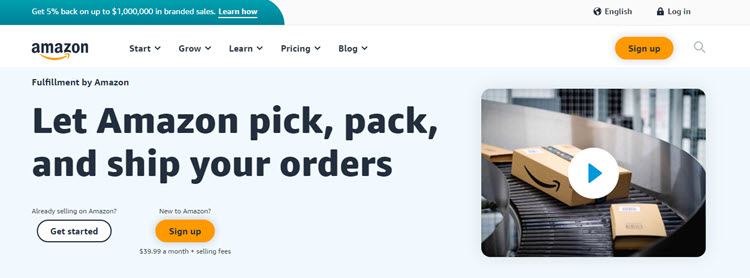
Fulfillment by Amazon (FBA) provides fulfillment services from more than 140 global fulfillment centers and temperature-controlled warehouses. Their omnipresence ensures fast shipping and different shipping discounts worldwide.
Part of the largest global ecommerce player, Amazon, FBA provides fast delivery services, meeting customers’ shipping expectations.
FBA has an easy returns policy, meaning that they handle returns on merchants’ behalf, if such an agreement is arranged between the merchant and FBA. Merchants can sell via different channels using FBA and offer 24/7 customer support. Various shipping and payment solutions can be integrated with FBA, supporting ecommerce merchants planning to spread to new markets or provide alternative payment methods to their buyers.
Rakuten
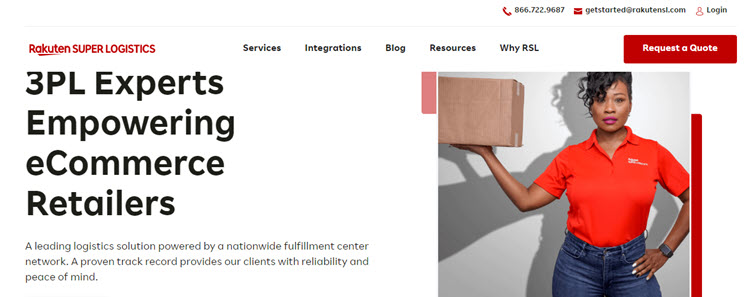
Rakuten Super Logistics is the largest Japanese ecommerce fulfillment provider, also running the country’s largest credit card company and online bank. This integration of fulfillment and financial services makes Rakuten a fine choice for ecommerce merchants who want to have their business operations managed by the same provider.
Rakuten Super Logistics uses a cloud-based inventory and order management system to process customer orders. Thanks to ground shipping, they provide 1-, 2-day delivery to any region in the US.
They have quota-based pricing, arranged according to the monthly order volume a merchant receives. This fulfillment company demands a minimum of 250 orders a month, while Rakuten can handle more than 10,000 orders.
Rakuten provides efficient client support, with a response time of under 3 hours.
FedEx Fulfillment

FedEx Fulfillment is an integrated supply chain solution relying on the traditional FedEx transportation system to provide merchants with a complete fulfillment circle.
It helps small and mid-sized enterprises (SMEs) accept, process, and ship orders via various channels.
Merchants can also use FedEx Fulfillment to track orders, manage inventory, follow ecommerce trends, and monitor their shoppers’ behavior to bring sound business decisions.
Some of the unique features that FedEx Fulfillment offers are the same-day delivery cut-off times, a frictionless returns procedure, and two-day ground shipping to most of the US. Merchants working with this fulfillment company get white label shipping boxes where they can put their brand’s logo, instead of the FedEx logo.
Rapid Fulfillment
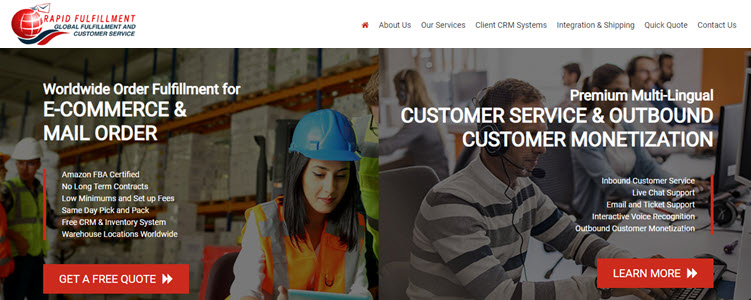
Rapid Fulfillment provides all fulfillment services, from order management and warehousing to inventory management and worldwide delivery. It ensures 24/7 tracking of merchants’ stock and orders via their dedicated CRM tool, accessible from both desktop and mobile devices.
Rapid Fulfilment’s systems are entirely integrated with leading shopping carts, and merchants pay only an initial integration fee to get things going without any recurring fees. Merchants can count on Rapid Fulfillment’s cutting-edge customer service tools, like interactive voice recognition, live chat support, and call agents.
Rapid Fulfillment also has an established returns management system, including assessment procedures for the disposal or reissue of returned products.
Note: Rapid Fulfilment is an official CCBill integration partner that ensures high-quality services to all CCBill Merchants.
ShipBob
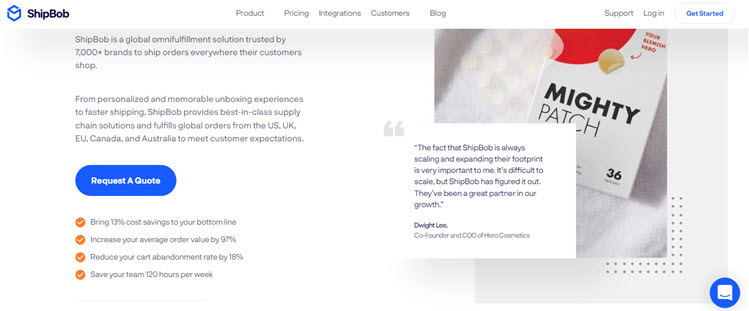
ShipBob is a fulfillment service that covers different channels to receive orders in line with merchants’ requests. It offers practical integrations with leading ecommerce solutions, such as Magento, Shopify, and WooCommerce.
ShipBob highlights its two-day product delivery period and free order management. Since it is a cloud-based fulfillment system, merchants can track reports and use analytics to run their ecommerce business. Also, the system is easily updated in real-time.
This reliable carrier also handles returns.
Rapid Fulfillment also has an established returns management system, including assessment procedures for the disposal or reissue of returned products.
ShipMonk
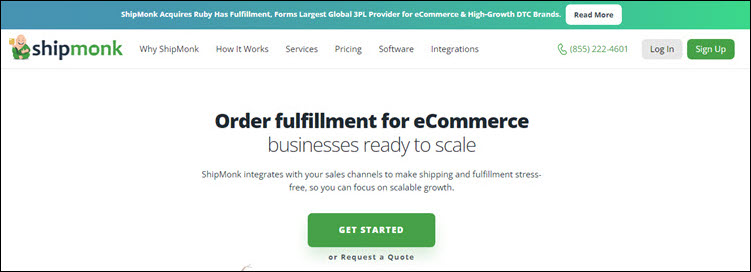
ShipMonk is an ecommerce fulfillment system that synchronizes in real-time with the merchant’s shopping cart and automatically accepts fulfillment orders.
As it can process more than 10,000 orders per day and there is no minimum number of orders, ShipMonk is suitable for businesses of all sizes. Merchants can distribute their products directly from their suppliers to different warehouses, from which orders are sent to customers.
Merchants can smoothly integrate ShipMonk with major ecommerce platforms, like BigCommerce, Shopify, and 3dcart.
ShipMonk’s fulfillment software provides a cutting-edge service by choosing the best available shipping method. Also, it verifies every buyer’s address, minimizing the risk of lost orders. Once a customer completes their order on the merchant’s website, the software sends an email with an order-tracking number to the customer. Merchants can set rules regarding custom packaging that the company staff will follow.
ShipStation

ShipStation is a fulfillment service company that provides integration with both leading ecommerce platforms and top online marketplaces, such as eBay, Walmart, and Amazon. Merchants and customers alike can track orders via its website.
ShipStation helps merchants find affordable shipping prices by comparing carriers’ rates and shipping times. This way merchants can choose the right delivery service in line with their budget and their customers’ shipping expectations.
Merchants can use the ShipStation mobile app to monitor all orders, and ShipStation sends tracking emails to customers.
There’s a 30-day free trial for ShipStation users on all apps, and there are six pricing tiers for companies so they can upscale or downscale the services they use based on their current needs.
RedStag
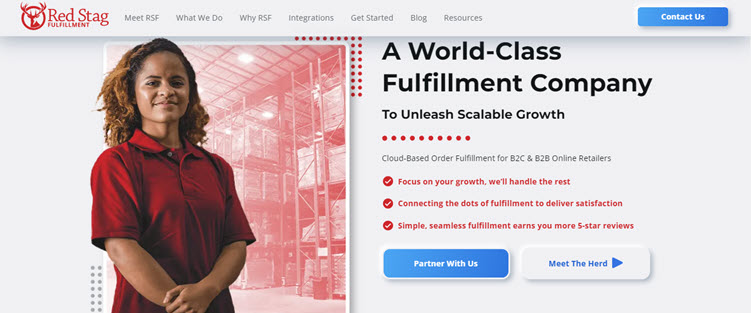
RedStagis a US-only fulfillment service provider with a 100% guarantee for two-day order fulfillment. This company highlights handling orders and shipments over 5 pounds as its specialty. It has an arrangement with FedEx for shipping large and heavy products, offering merchants discounts on such shipments. For all these features, RedStag is a suitable choice for merchants selling fragile, valuable, and large products and items that need to be assembled or customized before delivery.
This company applies cutting-edge quality control standards, such as video surveillance in their warehouses and packing places to reduce packing mistakes, mitigate theft risks, and prevent shipping damage. RedStag is a reasonable option for merchants with slow inventory turnover thanks to their lower warehouse fees.
Conclusion
Every ecommerce needs to make an additional effort to meet the demands of their customers for quick and effortless delivery.
Ecommerce fulfillment services help merchants process customers’ orders, package, ship and deliver the purchased products in the shortest time possible. They also help merchants supervise their inventory and deal with sudden surges in orders.
This guide helps merchants understand how each of these aspects works and how to best leverage the services of fulfillment providers for business growth.
